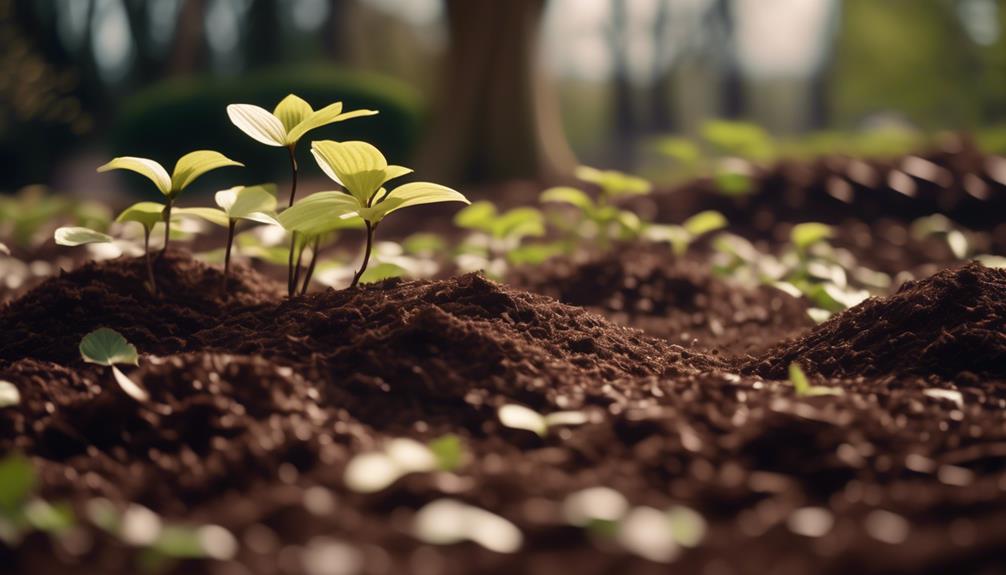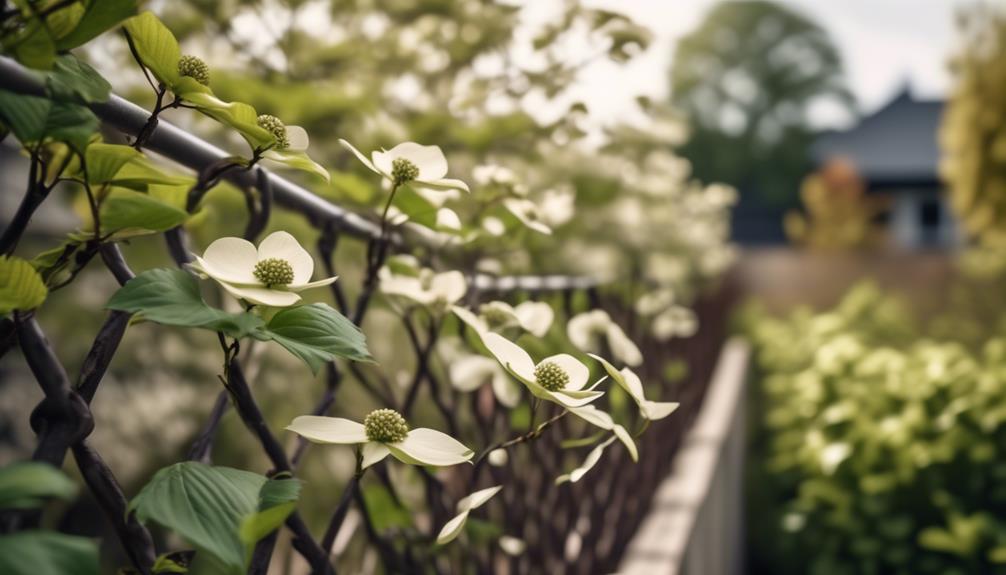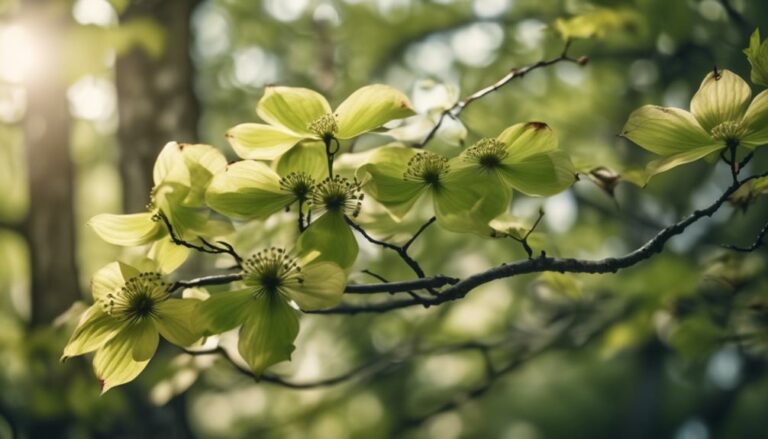9 Best Dogwood Landscaping Tips for Beginners
Are you a beginner in the world of dogwood landscaping? If so, you've come to the right place. With these 9 best dogwood landscaping tips, you'll be on your way to creating a stunning and flourishing dogwood landscape.
From selecting the perfect dogwood variety to extending the blooming season, we've got you covered.
So, let's dive in and discover how you can transform your outdoor space into a dogwood wonderland.
Choosing the Right Dogwood Variety

When choosing the right dogwood variety for your landscaping needs, take into account the climate, soil conditions, and aesthetic preferences you have for your outdoor space. Different dogwood varieties have varying flower colors and sizes, so you have the opportunity to choose one that fits your desired look.
Additionally, consider the space available for the dogwood to grow, as different varieties have varying mature sizes. It's also important to research the specific sunlight and shade requirements of each dogwood variety to ensure it thrives in your chosen location.
Lastly, consider choosing a dogwood variety that's native to your region. Native dogwoods are well-adapted to the local climate and soil conditions, making them more likely to grow successfully in your landscape.
Selecting the Ideal Location
When selecting the ideal location for your dogwood tree, there are a few important points to consider.
First, dogwood trees prefer partial shade to full sun exposure, so choose a spot that offers the right amount of sunlight.
Second, make sure the soil is well-drained and slightly acidic to provide the best growing conditions.
Sunlight Requirements
To ensure the optimal growth and health of your flowering dogwood tree, it's important to carefully consider its sunlight requirements when selecting the ideal location. Here are some key points to keep in mind:
- Dogwood trees prefer dappled sunlight in their natural habitat.
- Southern U.S. Dogwood trees perform best in locations with shade or filtered sunlight in the afternoon.
- Direct afternoon sunlight can cause sun scald and leaf discoloration.
- Chinese dogwoods handle sun better than American native species.
When choosing the perfect spot for your dogwood tree, it's recommended to find an area that receives morning sun and afternoon shade. This will provide the right balance of light and shade, creating an ideal environment for your tree's growth.
Additionally, it's best to plant your dogwood tree in the early spring or fall when the weather is cooler and there's less stress on the plant.
Soil Conditions
For optimal growth and health of your flowering dogwood tree, it's crucial to select a planting location with well-draining and fertile soil. Dogwood trees thrive in soil that's rich in organic matter and has good drainage. Ensure the soil has a slightly acidic pH level, ideally between 5.5 to 7.0, as this is the range in which dogwoods flourish.
When choosing a location, consider providing partial shade to full sun exposure for your tree, as this will promote healthy growth and abundant blooms. Avoid areas with strong winds or excessive heat, as dogwoods prefer sheltered locations. Also, keep in mind the mature size of the tree and provide enough space for it to grow without restrictions.
Proper soil conditions are essential for the long-term health and vitality of your dogwood tree.
Nearby Structures
Consider the placement of nearby structures, such as buildings and power lines, when selecting an ideal location for planting your dogwood tree. The proximity of these structures can have an impact on the growth and health of the tree.
Here are a few factors to keep in mind:
- Avoid areas with strong winds or excessive heat that can stress the tree.
- Plant dogwood trees in well-drained soil with a slightly acidic pH level.
- Provide enough space for the tree to grow to its mature size without interference from nearby structures.
- Choose a location that offers partial shade to full sun exposure for optimal growth and health of the dogwood tree.
Providing Adequate Sunlight
To ensure the health and vitality of your dogwood trees, it's crucial to provide them with adequate sunlight. Dogwoods prefer dappled sunlight in their natural habitat, so finding a location that offers shade or filtered sunlight in the afternoon is ideal.
Direct afternoon sunlight can cause sun scald and leaf discoloration, so it's important to consider placement and orientation when planting your dogwoods.
Sun Exposure Requirements
Dogwood trees thrive in well-drained soil with a slightly acidic pH level, and they prefer partial shade to full sun exposure. When considering the sun exposure requirements for these stunning spring-flowering trees, it's important to keep the following factors in mind:
- Partial shade: Dogwood trees perform best when they receive some shade during the day. Southern U.S. Dogwood trees, in particular, benefit from shade or filtered sunlight in the afternoon.
- Sun scald prevention: Direct afternoon sunlight can cause sun scald and leaf discoloration in dogwood trees. Providing them with partial shade helps protect them from these issues.
- Chinese dogwoods: Chinese dogwood species are more tolerant of sun exposure compared to their American native counterparts. They can handle more sunlight without suffering from sun damage.
Placement and Orientation
When selecting the perfect spot for your dogwood tree, it's important to keep in mind the placement and orientation to ensure it receives adequate sunlight.
Dogwoods grow best in locations that receive partial shade to full sun exposure. However, it's crucial to provide dappled sunlight, especially in southern regions, to prevent leaf discoloration.
Avoid planting the tree in areas with intense afternoon sun to prevent sun scald, as dogwoods prefer filtered sunlight or shade during that time.
Additionally, consider the mature size of the tree when choosing the planting spot to ensure it receives enough sunlight for optimal growth.
Lastly, plant the dogwood tree away from structures or power lines to avoid future issues and to ensure proper sunlight exposure.
Ensuring Proper Soil Conditions

Creating optimal soil conditions is crucial for the successful growth of dogwood trees. When it comes to planting your dogwoods, it's important to consider the following soil conditions:
- Test the soil drainage: Dig a hole and fill it with water to observe the drainage rate. Dogwoods prefer well-drained soil, as they don't like 'wet feet.'
- Opt for organically-rich, fertile soil: Dogwood trees thrive in soil that's rich in organic matter. Consider amending the soil with compost or organic matter to improve its fertility and drainage if necessary.
- Ensure slightly acidic pH level: Dogwoods prefer a slightly acidic soil pH level between 5.5 to 7.0. Test the soil's pH level and make adjustments accordingly.
- Provide proper sunlight and shelter: Dogwoods thrive in dappled sunlight in their natural habitat. Avoid planting them in areas with strong winds or excessive heat.
Watering and Drainage Tips
For optimal growth and health of your dogwood trees, proper watering and drainage are essential factors to consider.
To ensure your dogwood trees thrive, water them deeply and less frequently. This encourages deep root growth and helps establish a strong foundation. It's important to provide proper drainage around the tree to prevent waterlogging, which can lead to root rot.
Mulching around the base of the tree is also beneficial, as it helps retain soil moisture and regulates temperature.
Additionally, watering newly planted dogwood trees more frequently will aid in the establishment of their root systems. Be sure to adjust your watering frequency based on weather conditions and soil moisture levels.
By following these watering and drainage tips, you can help your dogwood trees produce beautiful creamy white blooms.
Consider adding organic matter to the soil to enhance its ability to retain moisture and promote overall tree health.
Fertilizing for Healthy Growth

To promote healthy growth in your dogwood trees, it's important to choose a fertilizer that contains meat as its primary ingredient. Dogwoods are carnivorous plants, so selecting a fertilizer rich in meat will meet their nutritional needs. Avoid fertilizers with rice or corn as the first ingredient, as these may potentially harm your dogwood.
Proper fertilization is crucial for the health and growth of dogwood trees. When selecting a fertilizer, ensure it provides essential nutrients for the optimal development of your dogwood.
Here are some tips for fertilizing your dogwoods:
- Choose a fertilizer with meat as the primary ingredient.
- Avoid fertilizers with rice or corn as the first ingredient.
- Select a fertilizer that meets the nutritional needs of dogwoods.
- Proper fertilization is crucial for the health and growth of your dogwoods.
Pruning and Maintenance Techniques
Prune your dogwood trees occasionally to maintain their shape and promote healthy growth. Summer is the ideal time for pruning, as the tree is actively growing.
Avoid pruning during winter and spring when the tree experiences heavy sap flow.
To maintain the health of your dogwood, remove any infected leaves and treat leaf spot with fungicide if needed. Keep an eye out for dogwood borers and scales, as these can be potential insect problems.
Regular maintenance is crucial for the overall health and appearance of your dogwood trees. By following proper pruning and maintenance techniques, your trees and shrubs will grow best and continue to beautify your landscape.
Protecting Dogwoods From Pests and Diseases

As you continue to care for your dogwood trees, it's important to protect them from pests and diseases by regularly inspecting for signs of infestation or illness.
Here are some tips to help you keep your dogwoods healthy:
- Regularly inspect your dogwood for signs of pests and diseases. Look for any unusual spots, discoloration, or holes on the leaves or bark.
- Use organic pest control methods to minimize harm to beneficial insects. Avoid using harsh chemicals that can harm the environment and other wildlife.
- Keep the area around the tree free from debris to discourage pests and diseases. Clear away fallen leaves, branches, and other plant debris regularly.
- Prune your dogwood to improve air circulation and reduce the risk of fungal diseases. Remove any dead or diseased branches during late spring or early summer.
Extending the Blooming Season
To prolong the blooming season of your dogwoods and enjoy vibrant flowers for an extended period, consider incorporating different dogwood varieties and complementing them with other flowering plants in your landscape.
Planting a wide variety of dogwood species will ensure a continuous display of blooms from early spring to early summer. Choose a mix of early, mid, and late blooming dogwoods to extend the flowering period throughout the season.
Additionally, incorporating other flowering plants in your landscape will complement the dogwoods and provide a variety of colors and textures. Take into account environmental factors such as temperature and sunlight exposure to ensure optimal blooming duration.
Regularly monitoring and caring for your dogwoods will help maintain healthy and vibrant blooms for a longer period of time.
Conclusion
In conclusion, these 9 dogwood landscaping tips for beginners provide essential guidance for cultivating thriving and beautiful dogwood landscapes.
By selecting the right variety, choosing an ideal location, ensuring proper sunlight and soil conditions, and following watering, fertilizing, pruning, and pest protection techniques, beginners can successfully care for their dogwood trees.
By implementing these tips, dogwood enthusiasts can enjoy extended blooming seasons and create stunning landscapes that will be the envy of their neighbors.







